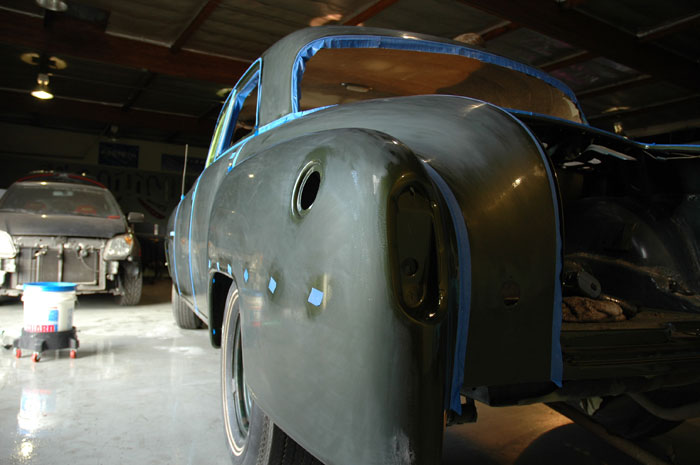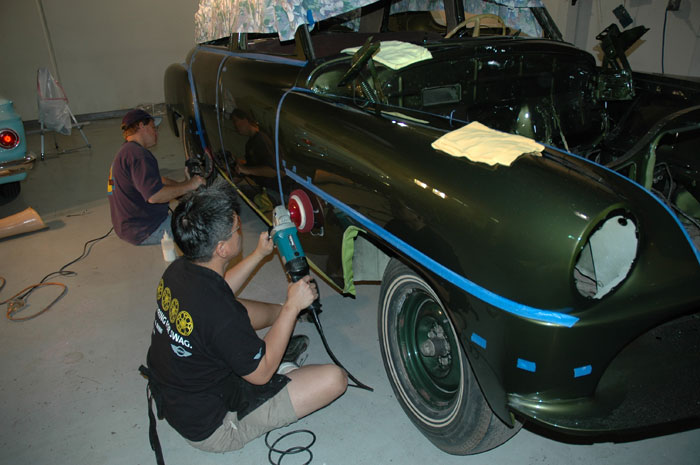Mike Phillips
Active member
- Dec 5, 2022
- 51,004
- 7
Knock out painted roofs first, then tackle the rest of the car...
This topic has come up in the past on this forum and other forums so here's a quick article on a technique that I use when doing multiple-step machine polishing procedures for show car work.
The idea is to knock out the roof from start to finish and then after the roof is completely polished and sealed, then cover it with something soft like a soft flannel bed sheet, and then tackle the rest of the car from the roof line downward.
Here's a couple reasons why to polish out the roof all the way to the wax or sealant step and then work down...
Now follow me on this...
If while you're working on the car you have not "finished section", then you have no way to showcase your work and talent to anyone that happens by, this could be the owner or a potential customer.
If all they can see is a "work in progress", there's nothing to get too excited about...
Now if you quickly work the roof all the way to the first application and removal of the wax or paint sealant step, now anytime someone walks by and comments or asks questions about your work you can make a "Presentation".
You talking to owner or potential customer...
In my experience, anyone looking at the finished results can then usually imagine how the rest of the car is going to look and that puts the "Big Picture" together enough for them to appreciate the work you're doing even though the rest of the car maybe taped-off and covered with compound residue...
That can be pretty powerful and even more so if there's any "original" paint or un-polished sections left that you can then show them before-and-after, even more so, you can leverage this if you have a Brinkmann Swirl Finder Light handy...
I found this picture of a 1952 DeSoto that Richard Lin and I dampsanded using Porter Cables before dampsanding was a commonly used detailing term.
The flannel bed sheet is covering the roof because at the point in time this picture was taken the paint on the roof had been sanded, compounded, machine polished twice and machine sealed. We didn't want any airborne dust landing and settling on the paint while we continued to work downward.

Of course, it goes without saying that this "style" of doing a multiple-step process to a car is "personal preference" and each person can find a way that works best for them... this is just what tends to work best for me...

1952 DeSoto - Roof has been sanded, cut, polished and waxed and is now protected with a soft flannel sheet


This topic has come up in the past on this forum and other forums so here's a quick article on a technique that I use when doing multiple-step machine polishing procedures for show car work.
The idea is to knock out the roof from start to finish and then after the roof is completely polished and sealed, then cover it with something soft like a soft flannel bed sheet, and then tackle the rest of the car from the roof line downward.
Here's a couple reasons why to polish out the roof all the way to the wax or sealant step and then work down...
1. Reduce the potential
No chance of getting splatter on previously cleaned and polished surfaces below the roof line and then having to wipe the splatter off. This is part of "reducing the potential" for re-instilling scratches that have already been removed. While it's important to be careful and if you are careful then this isn't an issue, it's just my personal preference to know out the roof all the way to wax and not ever have to worry about wiping any kind of residue off a lower panel when moving onto any step after the first step...
2. Marketing
Doing a multiple step process to a car requires a lot of time. From the time you start to the time you've wiped the first coat of wax off could be anywhere from 10 to 12 hours to a couple of days depending upon the project.
No chance of getting splatter on previously cleaned and polished surfaces below the roof line and then having to wipe the splatter off. This is part of "reducing the potential" for re-instilling scratches that have already been removed. While it's important to be careful and if you are careful then this isn't an issue, it's just my personal preference to know out the roof all the way to wax and not ever have to worry about wiping any kind of residue off a lower panel when moving onto any step after the first step...
2. Marketing
Doing a multiple step process to a car requires a lot of time. From the time you start to the time you've wiped the first coat of wax off could be anywhere from 10 to 12 hours to a couple of days depending upon the project.
Now follow me on this...
If while you're working on the car you have not "finished section", then you have no way to showcase your work and talent to anyone that happens by, this could be the owner or a potential customer.
If all they can see is a "work in progress", there's nothing to get too excited about...
Now if you quickly work the roof all the way to the first application and removal of the wax or paint sealant step, now anytime someone walks by and comments or asks questions about your work you can make a "Presentation".
You talking to owner or potential customer...
"Well I still have the lower portions of the car to finish but come here and check out the paint on the roof, this is how the ENTIRE car is going to look after I wipe off the last coat of wax..."
Then you carefully remove a little piece of painter's tape holding the soft, flannel sheet onto the roof and then pull the sheet back carefully and let whoever is standing there check out a perfectly polished, high gloss finish.
In my experience, anyone looking at the finished results can then usually imagine how the rest of the car is going to look and that puts the "Big Picture" together enough for them to appreciate the work you're doing even though the rest of the car maybe taped-off and covered with compound residue...
That can be pretty powerful and even more so if there's any "original" paint or un-polished sections left that you can then show them before-and-after, even more so, you can leverage this if you have a Brinkmann Swirl Finder Light handy...
I found this picture of a 1952 DeSoto that Richard Lin and I dampsanded using Porter Cables before dampsanding was a commonly used detailing term.
The flannel bed sheet is covering the roof because at the point in time this picture was taken the paint on the roof had been sanded, compounded, machine polished twice and machine sealed. We didn't want any airborne dust landing and settling on the paint while we continued to work downward.

Of course, it goes without saying that this "style" of doing a multiple-step process to a car is "personal preference" and each person can find a way that works best for them... this is just what tends to work best for me...













